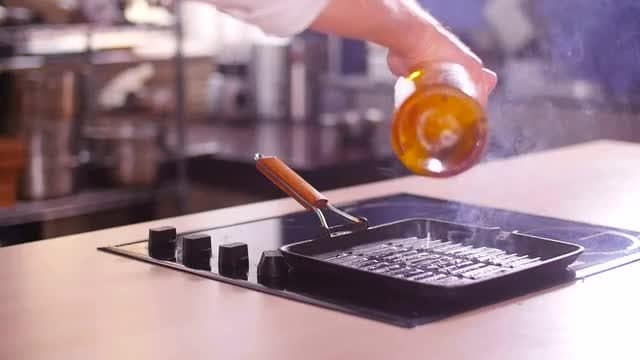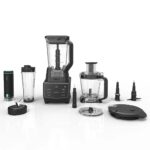You probably noticed something common in a lot of recipes that can be found online. At one point during preparation, you’ll have to heat oil to a certain temperature. If you just started to explore cooking and everything is pretty new to you, some questions are popping up. How do I know if oil is heated up to the right temperature? Should I just assume that the temperature is right? What if it’s not hot enough? Can I use a food thermometer for oil? All of these are valid questions to ask yourself.
Whether you are new in the cooking world or not, you probably heard about the food thermometer. It’s quite a common tool used in the kitchen. They are not pricey and they have multiple purposes. In this article, I will explain to you how a food thermometer works, and can you use it to measure oil temperature, and on top of that, I will suggest to you some of the models that I found to be a bit better than the rest of them. Let’s get down to business!
What is a Food Thermometer?
First, let’s answer this question. A food thermometer is a device that is being used similarly to the thermometer that we use to measure our body temperature. There are several different models and types, but we will cover that a bit later. This useful kitchen tool is mostly used to measure the temperature of the meat. Perfect steak preparation heavily relies on the right meat temperature. But, you can use it for a bunch of other meals. Just for an example, you can measure the temperature of the water, candy, and of course, oil.
Types of Food Thermometers
I like to divide three thermometers into three different types. Instant-read thermometers, meat thermometers, and deep-fry thermometers. Let’s check them all out and see what their differences are.
Instant-Read Thermometer
This one has a pretty wide usage. It’s coming in various shapes and colors, but all of them operate the same. An instant-read thermometer consists of two parts. Needle-like piece of stainless steel (probe) and plastic or steel handle that has a digital readout on it. Most of them have a probe that can be folded (like a Swiss knife), and they operate on batteries.
The main purpose of this type of thermometer is to quickly find out the temperature of your food. Stick the probe into your food for fifteen to twenty seconds and you’ll get the temperature reading. That is the main reason why this kitchen tool is named “instant-read”. Feel free to use this type of food thermometer for oil, but I want to point out that this one is used for a quick check of the temperature. Do not leave it in the oven, pot, or pan during cooking!
Meat Thermometer
A meat thermometer has one major difference in comparison to an instant-read thermometer. Unlike the instant one, a meat thermometer is meant to stay in the oven or pot throughout the whole roasting process. Meat thermometers also come with an analog and digital reader. I prefer the ones with the analog reader. They have bigger displays and it’s way easier to read out the temperature without opening the oven or pot.
This type of thermometer is working on the same principle. You stick the probe into the meat and that’s it. Generally speaking, the probe is a bit longer than it is on an instant-read thermometer. A lot of barbecue master chefs will tell you that you have to know the temperature of your steak if you want it to turn out flawlessly.
This food thermometer shouldn’t be used for oil. It can be quite clunky and hard to handle and you don’t want to burn yourself with hot oil!
Deep-Fry Thermometer
In reality, this type of food thermometer is meant to be used for oil. For deep-frying, oil temperature has to hit high heat degrees. In some cases, temperatures over 375°F are needed. These thermometers are designed to withstand such temperatures.
The material from which they are made is glass. Modern deep-fry thermometers are coming with a clip. The purpose of the clip is to put it into a pot or pan securely without the fear that it will fall into the searing oil. Additionally, on the right side of the reader (which looks like a regular house thermometer), you will have a guide that will show you how hot oil has to be for a certain type of dish or meal preparation.
Overall, this type of food thermometer is the one that you should use to measure oil temperature. After all, that is the purpose of it.
How to Use Food Thermometer the Right Way – 5 Easy Steps
Further in the article, I will recommend some of the thermometers that I find to be the best buy at the point of writing. But first and foremost, you need to learn how to use food thermometers properly. I’ll cover the usage in five steps.
Step 1:
Right after you take your new thermometer from the packaging, test it. Put in a bowl of ice-cold or boiling water to see if the reader will give you and kind of temperature reading. If the reader reacts, your thermometer is working.
Step 2:
Just because the reader is working, it doesn’t mean that it’s accurate. In other words, you need to calibrate it. Calibration instructions can be different from device to device. Make sure that you read the manufacturer’s instructions when it comes to calibration!
Step 3:
This step is directly involved with the usage during the cooking or roasting. The placement of the thermometer is very important! Correct placement can make all the difference when it comes to heat tempering. Below you can find a table that explains where thermometers should be placed in certain types of dishes.
| TYPE OF FOOD | WHERE TO PLACE THE THERMOMETER |
| Red Meat – Beef or pork steaks, burgers, mutton, etc. | Stick the probe into the thickest part of the meat. Aim for the piece of meat where you will miss bones and fat. |
| Fish | This one can often be tricky because fish meat is very tender and flaky. However, the process is the same as it is with red meat. Stick the probe into the thickest part of the fish. |
| Oil and candy | It’s important to realize that it’s best to use a food thermometer for deep frying when it comes to oil and candy heat. Just place the clip properly at the bottom of the pan or fryer and leave it there until you get the wanted temperature. |
| Wild animals and poultry – wild boar, deer, chicken, turkey, etc. | If you are cooking big chunks of meat like turkey breasts or wild boar roast, by all means, use the same procedure that is used for red meat. However, if you are cooking smaller parts like wings or chicken drumsticks, aim for the innermost part of the meat. Again, try to avoid bones. |
Step 4:
Give the thermometer enough time. Not every meat or dish requires the same amount to measure the temperature. With this in mind, make sure that you carefully follow the instructions that will come with your thermometer. Manufacturers will describe how long to keep a thermometer in the dish.
Step 5:
Taking proper care of your food thermometer is very important. Clean it after every use just like you would do with any other kitchen tool. With regular and proper cleaning you will make sure that your thermometer stays accurate, efficient, and bacteria-free.
Best Food Thermometers
Now you know what types of food thermometers we have and you know how to use them. It’s time for me to show you the list of my favorites. You won’t go wrong with these models. They are reliable and easy to use. Additionally, they are available at decent prices so you won’t have to spend a fortune on them.
Best Instant-Read Food Thermometer
This brilliant device is worth every penny! It can be used for pretty much everything because of its large two-inch reader and the probe that is similar in length. For example, I am using it for roasts, bbq grilling, water, and stews. It operates on a single AAA battery and comes with a bunch of neat features. Cleaning is also tremendously easy because ThermoPro TP 19 is completely waterproof!
- It will take only a couple of seconds to get a temperature reading. It’s by far the fastest food thermometer on the market.
- Motion sense activation and sleep function. In other words, it will turn itself on and off once the probe has been taken out or folded into the reader. The device goes to sleep when it’s set down. Battery lasts up to three thousand hours!
- Waterproof chassis is making sure that you can easily clean it. Just rinse it under hot water and dry it down.
- Magnetic chassis is there to enable you easy storing and keep the thermometer close when you are cooking. Just stick it onto your oven or refrigerator.
- It has a calibration function which makes calibrating automated and easy as a breeze.
Best Food Thermometer for Meat
I prefer analog thermometers when it comes to meat. Simply because they have a big display which can easily be checked out when the thermometer is in the oven. This particular model is my favorite. You can get it for 5 bucks and that is a real bargain.
- Large display which shows you what kind of temperature you are looking for based on the type of meat that you are preparing
- It’s made from stainless steel which makes it sturdy enough for years of use.
- The probe is long enough to be used on any type of meat. Two and a half inches is enough to stick the thermometer into a thick and juicy piece of beef or wild boar.
- Completely waterproof which makes it easy to wash it.
- Goes all the way to 220°F.
Best Food Thermometer for Oil and Candy
The best food thermometer to measure oil heat is the one that is meant to withstand high temperatures of boiling oil. And this one is my personal favorite. It is easy to use, it looks nice and on top of that, it’s very durable. Based on its low price, you wouldn’t assume that, but quite the contrary, this one delivers!
- An adjustable clip that makes sure it will fit into any pan or deep fryer.
- Measures temperature all the way to 400°F and it’s tremendously precise.
- You can read the temperature in Fahrenheit or celsius. Whatever you prefer.
- The thermometer is twelve inches long, you don’t have to worry about deep pots. It will fit!
- The manufacturer guarantees it will last for a lifetime.
Conclusion
And that is all that I had. Let me summarize. I explained what food thermometers really are. What are the most common types of thermometers and which ones to use to measure the heat of the oil. Additionally, I picked out my favorites so that it is easier for you to pick out the one that will fit you. I truly hope that I helped you and provided you with answers to some of your questions. Enjoy!





1 Comment